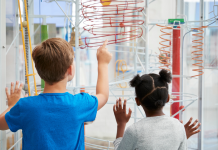We are living in uncharted territory these days. Constant updates, alerts, closings, and cancellations have us all uneasy and looking for answers. How can we help our children feel safe and secure when we don’t feel that way ourselves? It can be tricky, but it can be done. It may take some adjusting along the way, but we’ve got this.
 The National School Psychologists’ Association
The National School Psychologists’ Association
(NASP) has the following recommendations:
- Remain calm and reassuring. Kids look to adults to see how we react to help determine what their response will be. Reassure kids that they are safe and that you are there to help them stay as safe and healthy as possible.
- Make yourself available. Let kids know that you are there to listen and then make time to listen to them. Be sure to tell them you love them! Expect that your children might need more attention from you during these times.
- Monitor television watching and social media. (this is important for adults too!) Try to avoid watching things that might be upsetting to children. Give your children facts about the disease (when appropriate) and engage in activities other than TV and social media (like board games!).
- Maintain as normal a routine as possible. Establish some structure and familiar routine within your day- especially when children are going to be out of school for an extended period. They respond well when they know what to expect. Have dedicated work times and workspaces.
- Be honest. Watch for clues that children are ready to talk (they may only ask a question at a time or they might want to have an in-depth conversation).
- Review and model basic hygiene. Encourage children to wash their hands for at least 20 seconds (make it a game! Sing a song!), cover their mouths with a tissue or their elbow when they sneeze or cough, and encourage elbow bumps instead of handshakes.
What should you say to your child?
- For early elementary school children- keep the information simple and straightforward. Give examples of how people can stay healthy and focus on how adults are working to keep children safe.
- For upper elementary and early middle school children- help children sort through what is fact and what is fiction. Talk about what you (and your community leaders) are doing to help keep people healthy.
- For upper-middle school and high school students- provide factual information about COVID-19. Help them determine which are good sources to gain information from and which might not be.
For the complete NASP article: Click here
Another way to communicate with children- especially younger ones- is with comic strips and/or videos. Below are some great examples!
- What Kids Want to Know About Coronavirus
- So You’ve Got Questions about Coronavirus
- What is the Coronavirus?
- My Coronavirus Story
- Managing Coronavirus Anxiety
- Coronavirus












